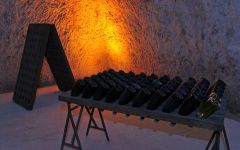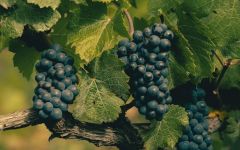Veuve Clicquot La Grande Dame 2006
- Decanter
-
Wine
Enthusiast -
Wine
Spectator -
Robert
Parker -
James
Suckling





Product Details
Your Rating
Somm Note
Winemaker Notes
La Grande Dame 2006 is an exclusive blend of Pinot Noir and Chardonnay from eight classic Grands Crus. In line with the style of the house, which is Pinot Noir dominant, the blend is 53% Pinot Noir and 47% Chardonnay. The wine has intense color with golden glints and very fine sparkling bubbles. Each cuvée of La Grande Dame has exceptional aging potential. The current vintage 2006 can be enjoyed now until 2025.
Professional Ratings
-
Decanter
How does Veuve Clicquot’s cellarmaster Dominique Demarville do it? This high wire Prestige Cuvée act walks the tightrope with such confidence and ease. Unusually for the house, the blend is just 53% Pinot Noir and 47% Chardonnay but like every great champagne its ‘ying and yang’ are in perfect symmetry. So we have the volume, structure and depth balanced by the cut and thrust of the acidity. On the palate are layers of cream, honey, nuts, brioche, pear, marzipan and ginger. The texture is shimmeringly silky and full. The finish alone deserves an ovation and demands an encore. Bravo. Drinking Window 2016 - 2030
-
Wine Enthusiast
Veuve Clicquot’s prestige cuvée is named after the widow Clicquot, the great lady who built up the house in the early 19th century. This latest incarnation is just showing signs of ripe toasty maturity. It is rich and soft with a high dosage, in the house style, with a full panoply of lime, red apple and apricot. Drink now and until 2022.
-
Wine Spectator
A waft of spring blossom draws you into this elegant Champagne, whose subtle notes of poached quince, toasted brioche and mandarin orange gracefully ride the satiny mousse, supported by a vibrant backbone of acidity. Disgorged February 2016. Drink now through 2029.
-
Robert Parker's Wine Advocate
The prestigious 2006 La Grande Dame is made from 47% Chardonnay and 53% Pinot Noir, and assembles the fruit of eight grand cru villages. Very intense and complex on the nose, this is a full-bodied, round, rich and mouth-filling, but also refined prestige cuvée; it reveals a fascinating purity, precision and freshness. The finish is long and complex, and shows a spicy minerality. There are coffee beans, bread and toast aromas in the aftertaste. This comes highly recommended.
-
James Suckling
The Grande Dame is looking bright, gently complex and a little spicy in 2006 where the grapefruit citrus is a strong influence on the nose, showing sweet florals, a little honeyed nougat and almond paste. The palate's bright and crisp and really has an air of fleshy depth and refinement. There's also a great warm, toasty finish that displays grilled hazelnuts. Great now through to to 2020 and beyond.
Other Vintages
2015-
Tasting
Panel -
Wilfred
Wong -
Wine
Spectator -
Wine
Enthusiast
-
Tasting
Panel -
Wine
Enthusiast - Decanter
-
Wine
Spectator
- Decanter
-
Jeb
Dunnuck -
Wine
Spectator -
Wine &
Spirits -
James
Suckling -
Robert
Parker
- Decanter
-
Wine
Spectator -
Wine
Enthusiast -
Wine &
Spirits
-
Wine &
Spirits -
Connoisseurs'
Guide -
Wine
Spectator -
Wine
Enthusiast
-
Robert
Parker -
Wine
Spectator -
Wine
Enthusiast
-
Wine
Spectator -
Wine &
Spirits -
Robert
Parker
-
Wine &
Spirits -
Wine
Enthusiast
-
Robert
Parker -
Wine
Enthusiast
-
Wine
Spectator -
Wine
Enthusiast
-
Robert
Parker









Learn about Veuve Clicquot, the history of the brand, its innovative winemaking techniques, and its signature Veuve Clicquot Yellow Label Brut Champagne.
History of Veuve Clicquot
Veuve Clicquot, now one of the largest Champagne Houses, was founded in 1772 by Philippe Clicquot under the label "Clicquot". After establishing the brand throughout Europe, Russia and the United States, Philippe was joined by his son, François Clicquot, at the head of the House in 1798. Seven years later, following his untimely death, François’ young widow, Barbe Ponsardin, took over the family business at just 27 years old. The House would subsequently be renamed in her honor: ‘Veuve Clicquot’ means ‘The Widow Clicquot.’
Innovating Champagne Production
Over the course of her lifetime, Madame Clicquot (Barbe Ponsardin), developed three of the most important innovations in Champagne that are still practiced today. First, in 1810 Veuve Clicquot produced the first vintage wine in Champagne, which otherwise produced non-vintage blends. Second, in 1816 Madame Clicquot invented the riddling table to clarify Veuve Clicquot champagne, and by doing so, she improved both the quality and finesse of the wines. Riddling is now fundamental to ‘La Methode Traditionelle’ (the traditional Champagne production method) and is emulated around the world. Finally, in 1818 Madame Clicquot created the first rose champagne made through ‘assemblage’, a method where white wines are blended with red wines.
Veuve Clicquot Yellow Label Brut
The distinctive, 90+ rated, Veuve Clicquot Yellow Label Brut has been in production since 1877. It is distinguished by the dominance of Pinot Noir in its blend, which gives strength, complexity and elegance to the champagne.
Veuve Clicquot La Grande Dame
The name La Grande Dame has been inspired by Madame Clicquot's nickname: La Grande Dame de la Champagne. 1972, the year Veuve Clicquot launched its first prestige cuvée to celebrate the bicentenary of the House. La Grande Dame respects Madame Clicquot's vision of Pinot Noir, which is about 90% since 2008, using mostly historical Grands Crus from their terroir.
Veuve Clicquot Pronunciation:
vœv kliko / vuhv klee-koh
100% of Veuve Clicquot vineyards use sustainable viticulture.

Representing the topmost expression of a Champagne house, a vintage Champagne is one made from the produce of a single, superior harvest year. Vintage Champagnes account for a mere 5% of total Champagne production and are produced about three times in a decade. Champagne is typically made as a blend of multiple years in order to preserve the house style; these will have non-vintage, or simply, NV on the label. The term, "vintage," as it applies to all wine, simply means a single harvest year.

Associated with luxury, celebration, and romance, the region, Champagne, is home to the world’s most prized sparkling wine. In order to bear the label, ‘Champagne’, a sparkling wine must originate from this northeastern region of France—called Champagne—and adhere to strict quality standards. Made up of the three towns Reims, Épernay, and Aÿ, it was here that the traditional method of sparkling wine production was both invented and perfected, birthing a winemaking technique as well as a flavor profile that is now emulated worldwide.
Well-drained, limestone and chalky soil defines much of the region, which lend a mineral component to its wines. Champagne’s cold, continental climate promotes ample acidity in its grapes but weather differences from year to year can create significant variation between vintages. While vintage Champagnes are produced in exceptional years, non-vintage cuvées are produced annually from a blend of several years in order to produce Champagnes that maintain a consistent house style.
With nearly negligible exceptions, . These can be blended together or bottled as individual varietal Champagnes, depending on the final style of wine desired. Chardonnay, the only white variety, contributes freshness, elegance, lively acidity and notes of citrus, orchard fruit and white flowers. Pinot Noir and its relative Pinot Meunier, provide the backbone to many blends, adding structure, body and supple red fruit flavors. Wines with a large proportion of Pinot Meunier will be ready to drink earlier, while Pinot Noir contributes to longevity. Whether it is white or rosé, most Champagne is made from a blend of red and white grapes—and uniquely, rosé is often produce by blending together red and white wine. A Champagne made exclusively from Chardonnay will be labeled as ‘blanc de blancs,’ while ones comprised of only red grapes are called ‘blanc de noirs.’
